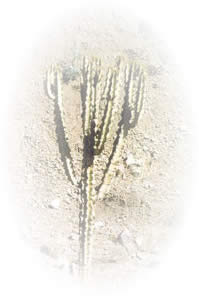

The purpose of 'Operation Desert Bloom' is to tackle these issues described in "The Background" with
the complementary use of two concepts: "aerial dissemination" and "micro-reservoir
modules".
A Unique Approach to Revegetation;
Operation
Desert Bloom allows for mass dissemination of seedlings with high rates
of seedling survival. Large-scale dissemination is achieved by means
of aerial application. Survival rate is improved by using modules and
systems (the "pod" concept) which contain super absorbent crystals
(1), growth promotion and
protection chemicals, as well as seeds of specifically selected plants.
This substitute for soil will allow the seed to germinate by drawing
moisture as required over the crucial first 5/6 weeks, thereby nursing
the seedling through the early critical stages of growth. The project
will therefore provide the conditions necessary to enable plant establishment
and colonisation in areas of desertified or degraded land.
After the pod is disseminated, it lies dormant until conditions (ie. rainfall,
flash floods and irrigation) trigger the start of the germination process. As
the super-absorbent polymer absorbs water, it swells, forming a micro reservoir
of plant-available water, which will be colonised and tapped by the roots of
the newly emerging seedling. Once the soil dries up, loss of water to evaporation
and percolation in the seedling environment is greatly reduced by the design
of the pod, thus increasing the chance of survival to establishment stage. As
the emerging shoots grow, an opening mechanism allows the root to grow down into
the ground. The pod is designed to be as biodegradable as possible, having no
harmful effect on the environment.
Outline of the Science;
Enormous progress has been made in recent years in the area of "micro-reservoir
technology". It seeks to address two of the fundamental problems arising
under such conditions. Firstly, to distribute seed combinations of desirable
species in areas where natural regeneration is severely impeded, and secondly
to avail the seeds of an appropriate support matrix to facilitate successful
establishment. It presents the advantage of having the flexibility to allow for
distribution by hand, from a moving vehicle, or from the air, enabling mass dissemination
- an ultimate objective.
The unique feature of this modular design is its ability to store very large
amounts of plant-available water and to retain that moisture against loss from
evaporation. Also the module absorbs and retains water for the sole use of the
contained seeds; consequently, the developing plants are targeted specifically,
with a minimal diverting influence on downstream waterflow.
The micro reservoir system includes use of super-absorbent polymers (2),
which have been extensively researched over the last 10 years and are now well
known. Although the composition and performance of such polymers vary, years
of comparative studies by independent institutions have indicated the products,
which perform best across a range of criteria.
Seed Selection;
The selection of the seed(s) to be disseminated is extremely important. The type
of seeds currently being considered are those which will produce plants that
can put roots down very quickly when water is available, so they can reach an
aquifer and use the water to survive in the drought. Suitable plant varieties
will also be selected on the basis that they are indigenous to the area, conducive
to halting soil erosion and degradation and that they are to the economic benefit
to indigenous populations of land that is populated.
The Micro-Reservoir Technology;
Preliminary investigations have demonstrated rapid and efficient entrapment
of rainwater by the module design, whilst laboratory experimentation
has confirmed their exceptional water retention characteristics. At temperatures
of around 40°C, water-loss by evaporation and other physical processes
was low enough to suggest that sufficient water would remain available
for plant growth for up to several months following rainfall, compared
with a few days under normal germination conditions in soil. The pod
has also been designed to reflect heat (thus preventing significant evaporation),
to permit taproot penetration of the underlying soil and to withstand
impact damage.
The Ecosphere design criteria are:
- Be suitable for use primarily in tropical/arid areas;
- Absorb rainwater and retain it using super-absorbents;
- Reflect heat and thus prevent significant evaporation;
- Contain a filter to improve the quality of ground water ingested and hydrated by the Ecosphere;
- Contain all necessary nutrients for the initial growth phase;
- Permit tap root penetration of the underlying soil as well as shoot penetration;
- Be light and yet strong enough to withstand impact damage possibly using a honeycomb-structured interior, and sufficiently repellent to the ravages of insects and goats.
- To be as bio-degradable as possible
N.B. Both 1 and 2 refer to the relatively new Hydro-gel technology where the polyacrilomide crystals absorb water, preferably fresh and clean, causing them to 'hydrate' to approximately 400 times its weight in water. © 2005 Desertbloom Organisation/Foundation